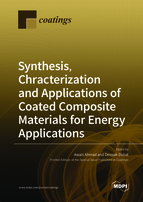Synthesis, Chracterization and Applications of Coated Composite Materials for Energy Applications
A special issue of Coatings (ISSN 2079-6412).
Deadline for manuscript submissions: closed (31 May 2021) | Viewed by 44947
Special Issue Editors
Interests: advanced functional materials and nanocomposites; energy storage devices; supercapacitors and batteries (Li/K and Al-batteries)
Special Issues, Collections and Topics in MDPI journals
Interests: nanomaterials; photocatalysis; energy applicatons; coated composite materials; biosensor; electrochemical sensor; photocatalysis
Special Issues, Collections and Topics in MDPI journals
Special Issue Information
Dear Colleagues,
The formulation of coated composite materials is an important field of research around the world today. Coated composite materials include inhomogeneous and anisotropic materials. These materials are formulated by an amalgamate minimum of two or more materials which accommodate different properties. These materials have a vast field of appealing applications that encourage scientists to work on them. Due to their unique properties, such as their strength, liability, swiftness, and low cost, they are used as a promising candidate for reliable applications in various fields, such as biomedical, engineering, energy devices, wastewater treatment, and agriculture. Different types of composite materials have had a noticeable impact in these fields already, such as glass, plastic, and most promisingly, metal oxide nanoparticles.
Developing countries have growing needs, and energy demand is expected to double by year 2050 and triple by the beginning of the next century. Thus, there is a very urgent need to develop a secondry source of energy which will be CO2-based but also free from conventional fossil fuel. The technology of empowering deals with very small-sized objects, including nanometer-sized objects, in the field known as nanotechnology. These objects have several chemical and physical properties on the basis of their size. Due to these properties, nanoparticles have been studied for the last 10 years, and today, nanomaterials are the most advanced material not only in terms of scientific knowledge but also commercial applications. It is predicted that nanotechnology will be established at various levels, including systems, materials, as well as devices.
Renewable energy has been formulated and produced with the emerging properties of coated materials, such as nanocomposites, which have a smaller size but larger surface area due to the ultimate avalibility of active sites which can be used for storage applications, CO2 capture, 02 fixation, removal of heavy metals via elecrochemical sensors, and photocatalyst degradation of organic pollutent. These materials which get connected with the derivatives of carbon such as CNTs, graphene, buckyballs, as well as ZIF-based structures, are a very well-known source for use in applications of hydrogen storage and electrical energy storage. In the field of energy storage, the most prominent and versatile features are batteries and capacitors. Thus, this Special Issue will focus on the various application domains of newly created coated composite materials for CO2 capture, single atom catalysis, biocatalyst catalysis, thermo-insulation, capacitor,s hydrogen, etc. in conversion, conversation, and energy storage.
Dr. Deepak P. Dubal
Dr. Awais Ahmad
Guest Editors
Manuscript Submission Information
Manuscripts should be submitted online at www.mdpi.com by registering and logging in to this website. Once you are registered, click here to go to the submission form. Manuscripts can be submitted until the deadline. All submissions that pass pre-check are peer-reviewed. Accepted papers will be published continuously in the journal (as soon as accepted) and will be listed together on the special issue website. Research articles, review articles as well as short communications are invited. For planned papers, a title and short abstract (about 100 words) can be sent to the Editorial Office for announcement on this website.
Submitted manuscripts should not have been published previously, nor be under consideration for publication elsewhere (except conference proceedings papers). All manuscripts are thoroughly refereed through a single-blind peer-review process. A guide for authors and other relevant information for submission of manuscripts is available on the Instructions for Authors page. Coatings is an international peer-reviewed open access monthly journal published by MDPI.
Please visit the Instructions for Authors page before submitting a manuscript. The Article Processing Charge (APC) for publication in this open access journal is 2600 CHF (Swiss Francs). Submitted papers should be well formatted and use good English. Authors may use MDPI's English editing service prior to publication or during author revisions.
Dr. Deepak P. Dubal
Dr. Awais Ahmad
Guest Editors
Manuscript Submission Information
Manuscripts should be submitted online at www.mdpi.com by registering and logging in to this website. Once you are registered, click here to go to the submission form. Manuscripts can be submitted until the deadline. All submissions that pass pre-check are peer-reviewed. Accepted papers will be published continuously in the journal (as soon as accepted) and will be listed together on the special issue website. Research articles, review articles as well as short communications are invited. For planned papers, a title and short abstract (about 100 words) can be sent to the Editorial Office for announcement on this website.
Submitted manuscripts should not have been published previously, nor be under consideration for publication elsewhere (except conference proceedings papers). All manuscripts are thoroughly refereed through a single-blind peer-review process. A guide for authors and other relevant information for submission of manuscripts is available on the Instructions for Authors page. Coatings is an international peer-reviewed open access monthly journal published by MDPI.
Please visit the Instructions for Authors page before submitting a manuscript. The Article Processing Charge (APC) for publication in this open access journal is 2600 CHF (Swiss Francs). Submitted papers should be well formatted and use good English. Authors may use MDPI's English editing service prior to publication or during author revisions.
Keywords
- coated composite materials
- energy applications
- CO2 capturing
- O2 fixation
- water splitting
- photocatalysis







